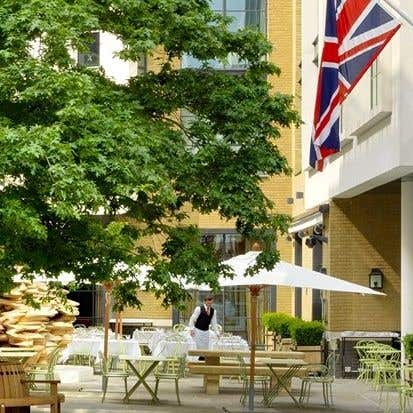This article is also published in the Financial Times.
Two meals at the restaurant in the recently opened Ham Yard Hotel in London left me contemplating the phrase ‘mmm, interesting’, words that takes on certain connotations among those writing about food and wine.
I most commonly hear this phrase from my wife, the FT’s wine correspondent, when early evening she selflessly tastes some of the many samples sent to her. She describes a wine thus that may have piqued her professional interest but isn’t quite good enough to travel the few metres to our dining table.
In the hands of those dealing with more solid matters, the adjective is often invoked to describe a dish that may please jaded professional palates but will not, necessarily, delight a broader audience.
The most fascinating aspects of Ham Yard, part of the Firmdale group that includes the Covent Garden and Knightsbridge hotels and the Crosby Street hotel in New York, relate to its location, history and distinctive charms.
Although it may sound as though it is be found in the old City of London, perhaps close to Pudding Lane, Ham Yard is in fact a 90-second walk from Piccadilly Circus in the busy West End. Its name derives from a pub that flourished there in the 18th century but extensive bomb damage meant that it was a no-go area for decades. A desolate car park marked the entrance where today the first UK outpost of the quirky Australian company, Dinosaur Designs, now stands.
Beyond that is a courtyard full of tables and chairs with glass doors that lead into a large bar and a restaurant, both of which benefit from two essential aspects of life that are increasingly at a premium in our crowded cities: a sense of space and lots of natural light.
The light streams in not just at the front but also via the glass windows at the back of the ground floor of what is an impressively spacious hotel that covers 6,000 sq metres and boasts a bowling alley in the basement. The interior design is ultra-modern – and will strike some as colourful, others as confusing.
The specific benefits for the diner are that there is far more space at and between the tables than in any other restaurant in Soho and, as a consequence, the acoustics are much better than most. It is no surprise that a literary agent friend has made this restaurant his current favourite for his daily lunch ritual with any one of the many authors he represents.
At first sight there appears to be another obvious attraction: the menu prices seem very reasonable. All first courses are under £10; only one of eight main courses is over £20 (the veal cutlet, an expensive and in this instance generous cut); all desserts are £5. 'These are prices most usually seen in pubs', opined my dining companion, a supplier of fruit and vegetables, who, as a further compliment, rattled off quite how many expensive ingredients the chef was incorporating: baby artichokes (£1.40 each), girolles (£22 a kilo), and seaweed (£20 a kilo).
Our first lunch began brightly with a variation on crab and egg. The crabmeat was freshly picked without any overtones of having been in the fridge too long; the duck egg, poached and served warm with the yolk just the correct consistency. There was carefully picked watercress on the side. A salad of peaches, ham and Berkswell cheese worked well while the now very common first course of burrata, that tactile combination of mozzarella and cream, and heritage tomatoes on my return was let down by a large slice of an unripe green tomato.
But by this stage in both meals, I had begun to sense that something was not right. It did not come as a surprise that the waiter on the first occasion failed to mention any of the prices of that day’s three specials, but on the second occasion the waitress asked us whether we wanted any side orders with our main courses, side orders not mentioned at all on the menu. When on that occasion my French friend ordered his daily fix of frites, they appeared on the bill at £4. This is certainly not best practice nor is allowing a manageress to walk through the restaurant chewing gum.
And it was this apparent lack of interest in the fine details of running a restaurant that seemed to engulf the kitchen. Whoever cooked the veal cutlet had not allowed it to caramelise as it should, and too much unnecessary sauce had turned the runner beans and courgette flower that lay underneath the meat soggy by the time they were served. A fillet of cod had been poached correctly but the unnecessary slice of pancetta on top of it had also met a damp end, having fallen into parsley risotto underneath. The desserts are either hefty (the slice of chocolate and praline cake is enormous) or, in the case of the plum and almond tart, markedly undercooked.
At the bottom of the menu, Tim and Kit Kemp, who created the Firmdale group, write somewhat vacuously, ‘We hope you enjoy your meal.’ The Kemps and their senior management need to do far more: to sit as critical customers to rectify all that is wrong with this menu and the rather ill-conceived wine list. Then they could have a restaurant of great interest.
Ham Yard One Ham Yard, London W1D 7DT; tel +44 (0)20 3642 2000
The photo is taken from the Firmdale hotels' website.

